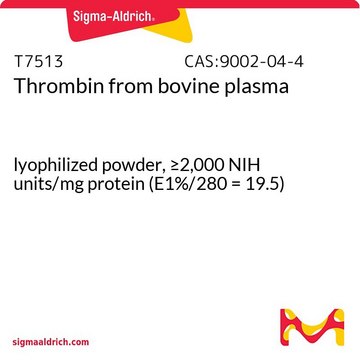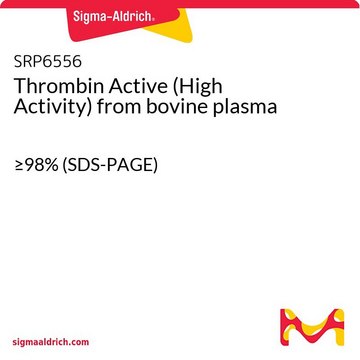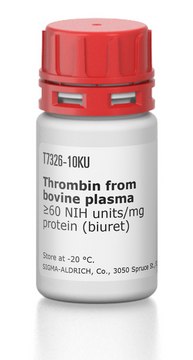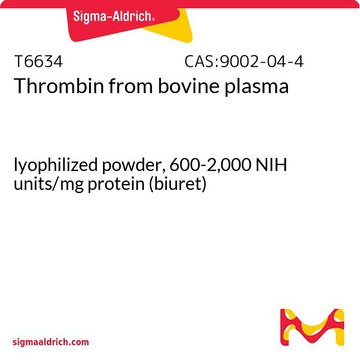T5772
Thrombin from rat plasma
lyophilized powder, ≥1,000 units/mg protein (biuret)
Sign Into View Organizational & Contract Pricing
All Photos(1)
About This Item
Recommended Products
General description
Thrombin is the final coagulation protease in regard to hemostasis, promoting both procoagulant and anticoagulant effects.
Application
Thrombin is used for site specific cleavage of recombinant fusion proteins containing an accessible thrombin recognition site for removal of affinity tags.
Thrombin is used for site specific cleavage of recombinant fusion proteins containing an accessible thrombin recognition site for removal of affinity tags. Thrombin has been used in a study to investigate activation of equine platelet-rich plasma.
Biochem/physiol Actions
Serine protease that selectively cleaves Arg-Gly bonds in fibrinogen to form fibrin and fibrinopeptides A and B.
Unit Definition
Activity is expressed in NIH units obtained by direct comparison to a NIH Thrombin Reference Standard, Lot K.
Physical form
Lyophilized from saline sodium citrate buffer, pH 6.5
Analysis Note
The NIH assay procedure uses 0.2 ml diluted plasma (1:1 with saline) as a substrate and 0.1 ml of thrombin sample (stabilized in a 1% buffered albumin solution) based on a modification of the method of Biggs. Only clotting times in the range of 15-25 seconds are used for determining thrombin concentrations.
Other Notes
View more information on thrombin at www.sigma-aldrich.com/enzymeexplorer.
inhibitor
Product No.
Description
Pricing
Signal Word
Danger
Hazard Statements
Precautionary Statements
Hazard Classifications
Eye Irrit. 2 - Resp. Sens. 1 - Skin Irrit. 2 - STOT SE 3
Target Organs
Respiratory system
Storage Class Code
11 - Combustible Solids
WGK
WGK 2
Flash Point(F)
Not applicable
Flash Point(C)
Not applicable
Regulatory Information
动植物源性产品
Choose from one of the most recent versions:
Already Own This Product?
Find documentation for the products that you have recently purchased in the Document Library.
Xiaojun Chen et al.
Cell death discovery, 8(1), 189-189 (2022-04-12)
Spinal cord injury (SCI) will result in the significant elevation of thrombin production at lesion site via either breakage of blood-spinal cord barrier or upregulated expression within nerve cells. Thrombin-induced activation of the protease activated receptors (PARs) evokes various pathological
Jamie A Textor et al.
Veterinary surgery : VS, 41(7), 784-794 (2012-06-30)
To investigate and compare clinically relevant Platelet-rich plasma (PRP) activation methods. Experimental. PRP was prepared from 6 equine subjects. Activation of the PRP was performed by 4 methods (autologous thrombin, bovine thrombin, calcium chloride (CaCl(2) ), or freeze-thaw). The resultant
Ting Yang et al.
Journal of neuroinflammation, 19(1), 120-120 (2022-05-28)
The danger-associated molecular patterns (DAMPs) are critical contributors to the progressive neuropathology and thereafter affect the functional outcomes following spinal cord injury (SCI). Up to now, the regulatory mechanisms on their inducible production from the living cells remain elusive, aside
Inhibitory effect of apixaban compared with rivaroxaban and dabigatran on thrombin generation assay.
Pancras C Wong et al.
Hospital practice (1995), 41(1), 19-25 (2013-03-08)
The effect of the oral direct activated factor X (factor Xa) inhibitor apixaban on tissue factor-induced thrombin generation in human plasma was investigated in vitro using the calibrated automated thrombogram (CAT) method and compared with the oral direct factor Xa
Dabigatran: a nephrological way out.
Patricio A Pazmiño
The American journal of medicine, 126(4), e21-e21 (2013-03-20)
Articles
Thrombin Factor IIa is an endolytic serine protease that selectively cleaves the Arg--Gly bonds of fibrinogen to form fibrin and release fibrinopeptides A and B.
Our team of scientists has experience in all areas of research including Life Science, Material Science, Chemical Synthesis, Chromatography, Analytical and many others.
Contact Technical Service









